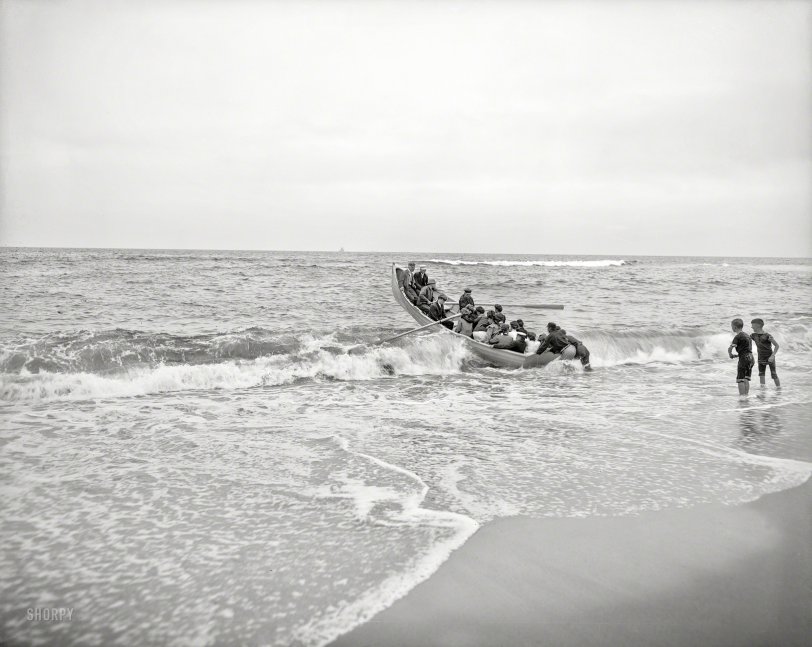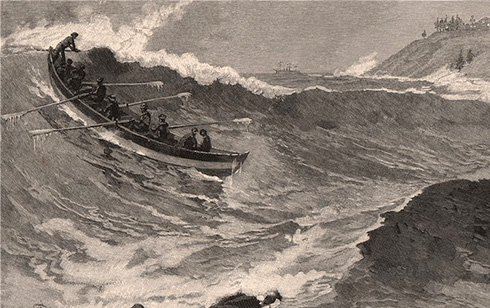


Framed or unframed, desk size to sofa size, printed by us in Arizona and Alabama since 2007. Explore now.
Shorpy is funded by you. Patreon contributors get an ad-free experience.
Learn more.

- Indiana Harbor Belt abides
- Freezing haze
- Corrections (for those who care)
- C&NW at Nelson
- Fallen Flags
- A dangerous job made worse
- Water Stop
- Passenger trains have right of way over freights?
- Coal
- Never ceases to amaze me.
- Still chuggin' (in model form)
- Great shot
- Westerly Breeze
- For the men, a trapeze
- Tickled
- Sense of loneliness ...
- 2 cents
- Charm City
- What an Outrage
- Brighton Park
- Catenary Supports
- Just a Little Before I was Born
- Afternoon normal
- The Flat Iron Cafe survives
- Aging in Place
- Raise your hand
- Good and Bad
- Oh, the 70's
- Nooooooi
- The aluminum tubing
Print Emporium
Wave Riders: 1903

Asbury Park, New Jersey, circa 1903. "Landing through the surf." 8x10 inch dry plate glass negative, Detroit Publishing Company. View full size.
Bowline, methinks
Why is everyone so sure there's no bowline in this picture. It's hard to see, but there seems to be some sort of straight white line near the bow of the boat.
[This is one of a series of photos showing both launching for and landing from an excursion on a fishing schooner off Asbury Park. Below: A "launch" photo with a different group of people. - Dave]

Curiouser and Curiouser
First, they are not using the method described by Admiral Knight because there's no sign of an anchor line. Second, the engraving of the stern-first method shows the condition of its use, which is surf heavy enough to provide a grave risk of having a wave break over the square stern. That is not the case here. Finally, if the two gents were really assisting in a landing, they are standing in front of a heavily laden boat that is coming at them at the speed of the surf, holding their arms straight. That is a good way to get run over and injured. In a proper landing they would be on either side, assisting the boat onto the beach. All that, plus the way the passengers are sitting and looking forward, reinforces the likelihood that this is a launch through light surf.
Re: Reverso
However, no such anchor line is in evidence. The simpler explanation is that whoever wrote the title was wrong.
arr, tis a launch
Having significant experience with both seafaring and talking like a pirate, I wish to weigh in on this one. It is almost certainly a launch pictured here, not a landing. The method described below by Admiral Austin Knight will work only if an anchor line is used from the bow, which is clearly absent in this photo. Without the line to keep the bow seaward, once the stern beaches the next wave will sweep the bow to the side, capsizing the boat and emptying its contents into the surf. In fact, the same can even happen with a poorly executed bow-first landing. I know because I have done it. Arrr.
Famous last words
The man said he's not taking us out far enough to need life jackets.
Reverso
They're not landing the skiff, but rather launching it. The men at the stern are pushing it. Also, you would normally land bow first, especially in heavy surf. The wave action would assist in the landing. With the bow seawards, it cuts the wave and actually wakes it more difficult to land.
["Landing through the surf" (the title of the etching below) is often done with the boat turned seaward. - Dave]
An officer in the US Coast Guard, who has much experience in landing through the surf, gives the following method as the safest and best for landing through the surf with a crew inexperienced in surf work -- place a 40 to 60 pound anchor in the bow with 100 to 150 fathoms of line. Just before getting into surf turn your boat to seaward, drop your anchor, pay out on line and one will usually find that the surge of the sea will take her to the beach fast enough, and if not, use your oars to back-in. Be careful to keep strain on line so that the boat will always be kept head-on to seas.
-- From the 1930 edition of "Modern Seamanship" by Rear Admiral Austin Knight, USN.

Accident-free fun!
Nothing could go wrong here, could it? Also love the boys -- excitedly at the edge of grown-up shenanigans.
























On Shorpy:
Today’s Top 5